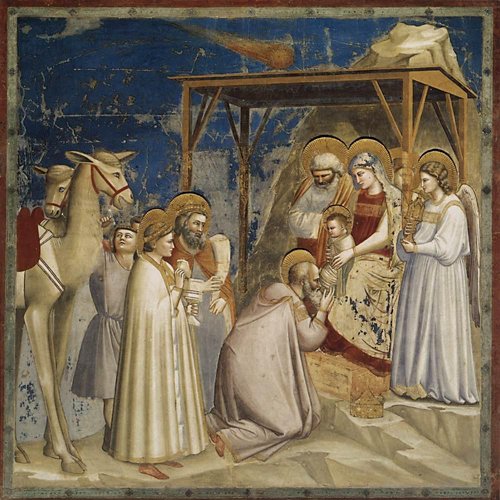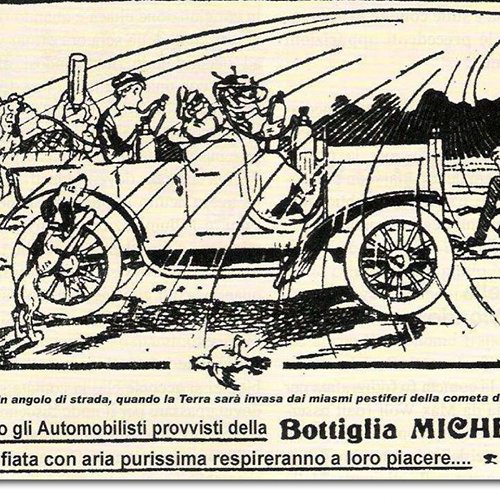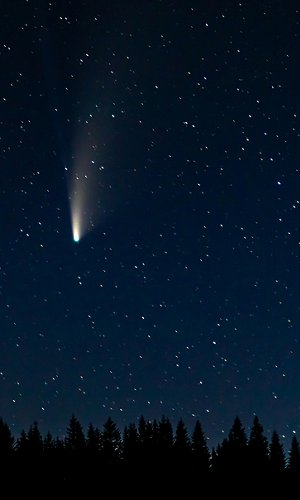The Star of the Magi competes with the Angel for the place of honour on the ridge-pole of the stable. Giotto began the tradition: enraptured by the passage of Halley’s comet in 1301, he was the first to paint the star above the Stable in the fresco of the Adoration of the Magi in the Scrovegni Chapel in Padua. In home-made nativity scenes, often the comet is applied to the crumpled paper used to form the cave; cave or stable, there are various schools of thought but they all share the luminous and reassuring presence of the Star which, according to legend, guided the Magi to the new-born Jesus.
Voice search

Twinkle twinkle little star

Giotto di Bondone. Adoration of the Magi (1303-1305). Padua, Scrovegni Chapel
Was it really a comet? According to the Gospels, Jesus was born in Bethlehem during the final years of the Reign of Herod the Great, that is between 7 and 4 BC. Ancient sources and astronomical reconstructions rule out the transit of a visible comet in those years. Halley’s comet crossed the sky in 12 AD, too late.
A supernova is a dying star that gathers together its remaining energy to produce a spectacular explosion in the firmament, but it is unlikely that the identity of the Star of Bethlehem can be attributed to an event of this significance because it would have been noted by the whole of mankind while there is no trace of such an event in historical sources.
Kepler, the great German astronomer, was the first to provide an alternative hypothesis. According to his calculations, performed manually on paper, in 7 BC Jupiter and Saturn were in a somewhat rare position known as planetary conjunction. A conjunction is an apparent proximity between celestial bodies, in practice the intense light of Jupiter combined with that of Saturn may have given the illusion of a bright star that disappeared when the planets moved away from one another. In reality, it may not have been very spectacular phenomenon, and may have been of interest only to experts: the Magi were wise men who interpreted the sky to predict the future. In effect, from the Gospel according to St. Matthew, the only one that speaks of the Star, it can be inferred that only the three wise men were able to see, but perhaps more correctly we should say interpret, the phenomenon as the star that would lead them to Jesus.
Snowball
The nature of comets holds within it something that reminds us of Christmas. In fact these small celestial objects are made of ice mixed with carbon dioxide, methane and dust: a kind of snowman made of dirty snow. When a comet gets close to the Sun its nucleus heats up and evaporates. Solar wind is a current of particles, protons and electrons, discharged by the Sun in every direction; it even reaches as far as Earth where it interacts with the atmosphere producing the northern lights. Solar particles push the vapours released by the nucleus into space: this is why the tail always stretches out on the side facing away from the Sun. And that is not all: since the nucleus is not made up only of frozen water, two tails form. The first, long and bright, is composed only of vapour and gas, while the second is shorter and dark and does not stretch out far from the nucleus because it is made up of dust, which is heavier. It is the tail that makes these objects visible and beautiful, and the tail is what gives it its name: in ancient Greek kométes means “with hair”.
The journey of a non-Jovian comet around the Sun is long and extends for the most part far from the central star. Halley’s comet reaches just beyond Neptune’s orbit and returns every 76 years. Others travel so far that they take thousands and even millions of years before appearing once again near us. Some pass by just once and then disappear forever.
Comets came into being together with the solar system. In the incandescent centre of the primordial nebula, the heavier materials gave rise to planets, while in the outer reaches the temperature was low enough to allow the water to freeze and aggregate in large icy nuclei. If compared with planets, the nuclei of comets are minute, but their tails can reach incredible dimensions sometimes equivalent to the diameter of the Sun.
Comets die too: some evaporate until they disappear, other fall into the sun attracted by its gravitational force; in very rare cases they plummet onto planets. In 1908 in Tunguska, Siberia, a small comet caused a catastrophic event when it crashed, fortunately in an uninhabited area, felling 60 million trees as if they were toothpicks. The Moon too shows the scars of numerous impacts with these celestial bodies.
The dark side
The comet breaks up the slow and regular motion of the stars in the sky, like a distant, silent and elegant thunderbolt. Mankind has seen them as gods and demons, benevolent beings or wicked bringers of misfortunes. Influenza is a contagious illness caused by a virus but its name is an ancient memory of when it was thought that the stars influenced the health of human beings: a superstition that in part still survives. In 1910, Earth crossed the tail of Halley’s comet causing panic in the misinformed public who thought that they were at risk of poisoning and pestilence. Some even had the idea of selling canisters of “purified air” to survive the toxic miasmas released by the comet.

Corriere della Sera, 17 May 1910. Advert for the “Michelin Bottle”
by Andrea Bellati




